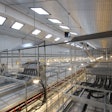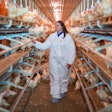The food industry’s version of the iPhone is the cage-free egg, according to an article in last month’s New York Times. Cage-free eggs “have become the latest addition to menus at universities, hotel changes like Omni, and cafeterias at companies like Google. The Whole Foods supermarket chain sells nothing else, and even Burger King is getting in on the trend,” the article says.
That said, “there is a lot of talk about cage-free, but are people really buying them? says United Egg Producers president and CEO Gene Gregory. “I think the consumer walking into the grocery store sees cage-free and they cost two or three times more, and they don’t buy them,” he says in the article. For all the talk about cage-free, according to UEP, cage-free layers have increased from 2 percent a few years ago to 5 percent today.
The article says that it takes about six months to build a cage-free operation, and the cost for well-designed facility is about $30 a bird, compared to $8 a bird for a battery cage operation.
The article says that much of the concern over battery cages is due to pressure from the Humane Society of the United States, which convinced Wolfgang Puck to switch all of the eggs used in his $360 million food empire to come from cage-free chickens certified by Humane Farm Animal Care. In 2003, the organization had two clients and certified 192,997 chickens. Today it certifies 14 companies and 1.9 million chickens.
But the issue is not black and white. The Times notes that Notre Dame, after visiting both caged and cage-free facilities, examining animal welfare, food safety, environmental impact and taste issues, decided to stick with its caged hen supplier, which had the edge in food safety. There are pros and cons to both systems, a Notre Dame official says.











